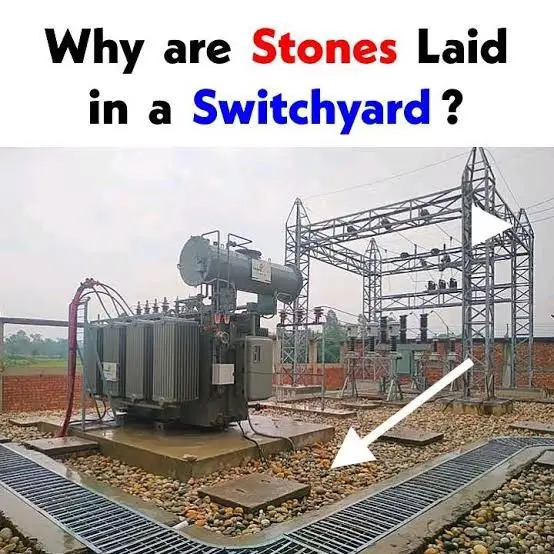Why are Stones/Gravel laid in Switchyard?
Grit and gravel are laid in switchyards for a variety of reasons. Firstly, they are used to facilitate drainage. Switchyards are exposed to various weather conditions, and the layer of grit and gravel allows water to percolate through the ground quickly. This helps prevent the accumulation of water, reducing the risk of equipment malfunctions, corrosion, or electrical hazards.
Secondly, grit and gravel enhance grounding in switchyards. They provide a conductive layer that improves the conductivity of the soil. This allows fault currents to flow effectively through the ground, reducing the risk of electrical shocks and ensuring the safe dissipation of fault currents.
Thirdly, they help control erosion. Switchyards are often situated in open areas, and grit and gravel stabilize the ground, preventing soil erosion caused by wind, rain, or water runoff. This ensures the stability of the switchyard infrastructure.
Fourthly, grit and gravel act as a fire-resistant layer. In the event of a fire caused by equipment failure or electrical faults, they help contain the flames and prevent them from spreading to other areas of the switchyard. This reduces the risk of damage to valuable equipment and enhances overall fire safety.
Lastly, grit and gravel provide a stable surface for workers to access the switchyard and perform maintenance tasks. They offer traction for vehicles and equipment, ensuring safe movement within the switchyard premises. This accessibility facilitates regular inspections, repairs, and maintenance activities.
स्विचयार्ड में पत्थर/बजरी क्यों बिछाये जाते हैं?
विभिन्न कारणों से ग्रिट और बजरी स्विचयार्ड में बिछाई जाती है। सबसे पहले, इनका उपयोग जल निकासी की सुविधा के लिए किया जाता है। स्विचयार्ड विभिन्न मौसम स्थितियों के संपर्क में आते हैं, और ग्रिट और बजरी की परत पानी को जल्दी से जमीन के माध्यम से रिसने देती है। यह पानी के संचय को रोकने में मदद करता है, उपकरण की खराबी, जंग या बिजली के खतरों के जोखिम को कम करता है।
दूसरे, ग्रिट और बजरी स्विचयार्ड में ग्राउंडिंग को बढ़ाते हैं। वे एक प्रवाहकीय परत प्रदान करते हैं जो मिट्टी की चालकता में सुधार करती है। यह फॉल्ट धाराओं को जमीन के माध्यम से प्रभावी ढंग से प्रवाहित करने की अनुमति देता है, जिससे बिजली के झटके का खतरा कम हो जाता है और फॉल्ट धाराओं का सुरक्षित अपव्यय सुनिश्चित होता है।
तीसरा, वे कटाव को नियंत्रित करने में मदद करते हैं। स्विचयार्ड अक्सर खुले क्षेत्रों में स्थित होते हैं, और मिट्टी और बजरी जमीन को स्थिर करते हैं, जिससे हवा, बारिश या पानी के बहाव के कारण होने वाले मिट्टी के कटाव को रोका जा सकता है। यह स्विचयार्ड बुनियादी ढांचे की स्थिरता सुनिश्चित करता है।
चौथा, ग्रिट और बजरी आग प्रतिरोधी परत के रूप में कार्य करते हैं। उपकरण की विफलता या विद्युत दोष के कारण आग लगने की स्थिति में, वे आग की लपटों को रोकने में मदद करते हैं और उन्हें स्विचयार्ड के अन्य क्षेत्रों में फैलने से रोकते हैं। इससे मूल्यवान उपकरणों के नुकसान का जोखिम कम हो जाता है और समग्र अग्नि सुरक्षा बढ़ जाती है।
अंत में, ग्रिट और बजरी श्रमिकों को स्विचयार्ड तक पहुंचने और रखरखाव कार्य करने के लिए एक स्थिर सतह प्रदान करते हैं। वे वाहनों और उपकरणों के लिए कर्षण प्रदान करते हैं, जिससे स्विचयार्ड परिसर के भीतर सुरक्षित आवाजाही सुनिश्चित होती है। यह पहुंच नियमित निरीक्षण, मरम्मत और रखरखाव गतिविधियों की सुविधा प्रदान करती है।




